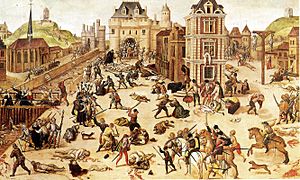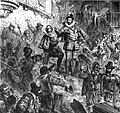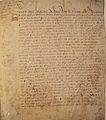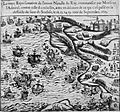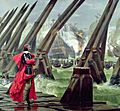French Wars of Religion facts for kids
The French Wars of Religion were a series of eight wars fought in France during the 16th century. These wars were mainly between Catholics and Protestants, who were also known as Huguenots. While religion played a big part, these wars were also about who held the most power in France. Regional rulers wanted more control, while the king wanted to centralize power.
The wars ended with the Catholics winning, but peace was finally made with the Treaty of Nantes in 1598. A terrible event called the St. Bartholomew's Day massacre happened during these wars, on the night of August 23-24, 1572.
Contents
What Caused the Wars?
The Rise of Protestantism
In the 1500s, new ideas about Christianity spread across Europe. This movement was called the Reformation. In France, many people became Protestants, following the ideas of leaders like John Calvin. These French Protestants were called Huguenots.
The kings of France were Catholic, and they saw the growing number of Huguenots as a threat to their power and the unity of the country. At first, some kings, like Francis I, were somewhat tolerant. But soon, they started to crack down on Protestant ideas.
Power Struggles and Politics
Even though these wars are called "wars of religion," they were also about power. Powerful noble families in France often used religion as a reason to fight for more control. Some noble families were Catholic, and others were Protestant. They wanted to influence the king and gain more land and wealth.
The kings of France wanted to have strong, central control over the whole country. But many local lords and nobles wanted to keep their own power in their regions. The religious differences gave them another reason to fight against the king's growing authority.
Key Events of the Wars
Early Conflicts
The tensions grew, leading to smaller clashes. One early event was the Amboise conspiracy in 1560. Some Huguenot nobles tried to kidnap the young King Francis II. This plot failed, and many Huguenots were executed. This showed how serious the conflict was becoming.
The first major war began in 1562 with the Massacre of Vassy. Catholic troops attacked a group of Huguenots worshipping in a barn. This event sparked widespread fighting across France. Cities like Lyon saw churches looted and violence between the two groups.
The St. Bartholomew's Day Massacre
One of the most tragic events of the wars was the St. Bartholomew's Day massacre in 1572. This happened during a time when it seemed like peace might be possible. Many Huguenot nobles had come to Paris for the wedding of the Protestant Henry of Navarre to the king's sister, Margaret.
However, on the night of August 23-24, 1572, thousands of Huguenots in Paris were killed by Catholics. The violence quickly spread to other parts of France. This massacre deeply shocked Europe and made the wars even more brutal.
The Catholic League and Henry IV
After the massacre, the wars continued. A powerful group called the Catholic League formed. They were very Catholic and wanted to stop Protestantism completely. They even opposed the king if they felt he wasn't strong enough against the Huguenots.
Eventually, Henry of Navarre, the Huguenot prince who had survived the massacre, became king of France. To bring peace to the country, he decided to convert to Catholicism. He famously said, "Paris is worth a mass," meaning becoming Catholic was worth it to gain control of the capital and end the wars.
Ending the Wars: The Edict of Nantes
In 1598, King Henry IV issued the Edict of Nantes. This was a very important document that finally brought an end to the French Wars of Religion. The Edict granted Huguenots significant rights, including:
- The freedom to practice their religion in certain areas.
- The right to hold public office.
- The right to build churches in specific places.
- The right to have fortified towns for their protection.
The Edict of Nantes was a big step towards religious tolerance in France. It allowed Catholics and Protestants to live side-by-side, even if not perfectly.
After the Wars
Even after the Edict of Nantes, the Huguenots still had some political and military power. Later, powerful figures like Cardinal Richelieu, who served King Louis XIII, worked to reduce this power. For example, the Siege of La Rochelle in 1627-1628 saw the royal army capture a major Huguenot stronghold. Richelieu wanted to make the king's power absolute, but he still allowed Huguenots to practice their religion.
However, under King Louis XIV, the rights of Huguenots were slowly taken away. The dragonnades were a harsh policy where soldiers were forced into Protestant homes to pressure them to convert. Finally, in 1685, Louis XIV canceled the Edict of Nantes completely. This led to many Huguenots leaving France, which hurt the country's economy and culture.
The French Wars of Religion were a long and difficult period in French history. They show how religion, politics, and power struggles can lead to widespread conflict.
Images for kids
-
John Calvin, whose ideas became central to French Protestantism
-
After an initial period of tolerance, Francis I repressed Reformist ideas
-
Queen regent Catherine de' Medici, circa 1560
-
Looting of the Churches of Lyon by the Calvinists, in 1562, Antoine Carot
-
Plate from Richard Rowlands, Theatrum Crudelitatum haereticorum nostri temporis (1587), depicting supposed Huguenot atrocities
-
The Duke of Guise during the Day of the Barricades.
-
Henry IV, as Hercules vanquishing the Lernaean Hydra (i.e. the Catholic League), by Toussaint Dubreuil, circa 1600. Louvre Museum.
-
The Edict of Nantes, April 1598
-
Richelieu, depicted at the 1627–1628 Siege of La Rochelle, put an end to the political and military autonomy of the Huguenots, while preserving their religious rights.
See also
 In Spanish: Guerras de religión de Francia para niños
In Spanish: Guerras de religión de Francia para niños


